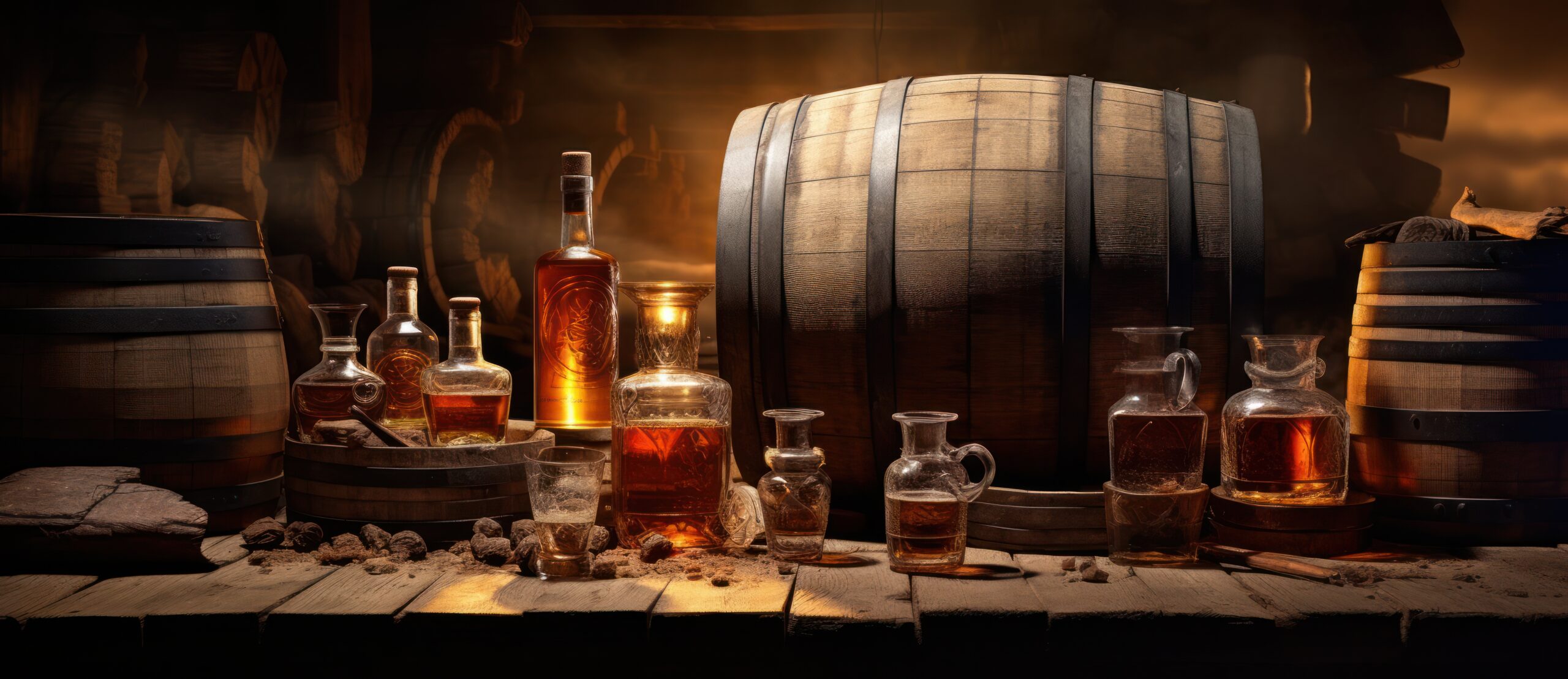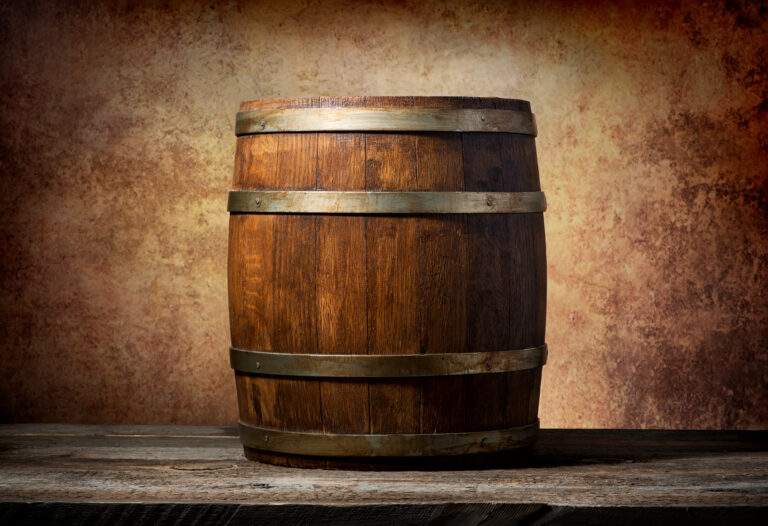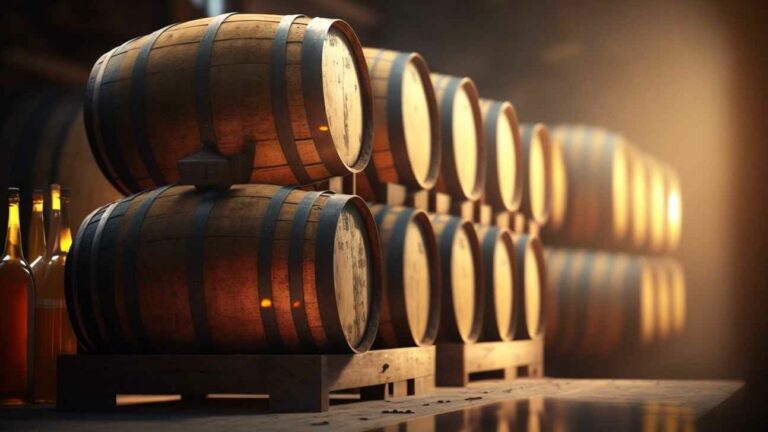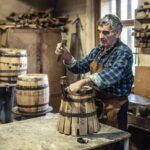Ever sipped whiskey and wondered why two brands, seemingly made with the same stuff, taste wildly different? The secret’s often hidden in the barrel, my friend. Think of the barrel as the unsung hero, silently shaping that golden liquid during aging. And here’s the kicker: how those barrels are moved around—what we call barrel transportation—has a surprisingly huge impact on the final taste.
As barrels journey, rolling and swaying, the whiskey inside gets cozy with the charred oak. This intimate dance extracts all sorts of delicious flavor compounds, painting the whiskey’s aroma, color, and taste profile. It’s like a tiny, flavor-packed workout! The more a barrel moves, the more intricate the flavor becomes. Some clever distilleries even intentionally ship barrels long distances by rail or sea just to amp up this effect. So, next time you savor your favorite whiskey, ponder the barrel’s adventure and how every little tumble and turn helped craft the deliciousness you’re enjoying. Truly, whiskey barrel transportation makes every sip an adventure in flavor.
The Science Behind Barrel Aging for Whiskey
Aging is absolutely critical to coaxing out those distinctive whiskey flavors. As whiskey matures in those trusty barrels, a complex symphony of chemical reactions unfolds between the liquor and the wood. The whiskey eagerly absorbs compounds like vanillin from the oak, gifting it those lovely notes of vanilla, caramel, and spice.
The Influence of Environment
Where and how barrels are aged significantly influences the final flavor. Barrels chillin’ in cooler climates tend to produce whiskies with a more pronounced oak influence, while those getting a suntan in hotter climates see accelerated aging, often leading to sweeter, fruitier flavors.
- In Scotland, the cool, damp climate means whiskies often boast robust oak, smoke, and peat notes.
- Kentucky’s humid summers and chilly winters see bourbons greedily absorbing caramel and vanilla flavors from charred oak barrels.
- Over in India, the hot climate produces whiskies with delightful tropical fruit flavors like mango in just a few short years.
When barrels embark on long-distance journeys, that sloshing and shaking of the liquor inside actually speeds up its interaction with the wood. The more those barrels are on the move, the faster those beautiful flavors develop. Some distillers wisely leverage this by shipping barrels far and wide to fine-tune the aging process.
Ultimately, everything from the type of oak to how the barrels are toasted or charred, and where they’re located, profoundly impacts a whiskey’s final flavor. By understanding how the environment and barrel characteristics play together during aging, distillers can conjure up an endless array of whiskeys. So, the next time you sip, truly appreciate the complex journey that went into developing that distinctive flavor.
How Wood Interacts With Whiskey During Aging
Transporting barrels exposes the whiskey to a fascinating dance of temperature changes and motion that truly alters its flavor. As the barrels roll and sway, the whiskey penetrates deeper into the wood, extracting even more of those precious compounds.
Temperature Changes
Temperature is a major player in how wood and whiskey interact. Warmer weather makes the wood expand, essentially opening up its pores and inviting the whiskey to dive in. When it gets colder, the wood contracts, gently squeezing out those compounds it absorbed during the warmer days. These temperature fluctuations create a brilliant “pumping effect,” significantly accelerating the infusion of wood compounds, like our friend vanillin, into the whiskey.
This expansion and contraction of the wood also plays a role in the whiskey’s proof. When it’s warm, the wood soaks up more water, which actually increases the whiskey’s alcohol concentration. Then, when it cools, that water is released again, lowering the proof. This cycle of concentration and dilution is key to creating a truly balanced, complex flavor.
Motion and Agitation
As barrels are transported, the whiskey’s movement causes it to splash and churn inside the barrel. This constant agitation, often called the “churning effect,” supercharges the infusion of wood compounds by increasing the whiskey’s contact with the barrel staves. The more a barrel is transported, the faster this infusion happens. Some savvy distillers even rotate barrels in their rickhouses to maximize this effect.
While temperature changes and motion influence all whiskeys during aging, transportation adds an extra dimension to flavor development. The journey a barrel takes truly shapes its whiskey’s unique character, creating flavors that simply can’t be replicated any other way. For us whiskey lovers, that first sip from a well-traveled barrel feels like tasting history in the making.
The Impact of Environmental Factors During Transportation
The environment that whiskey barrels experience during transportation and aging profoundly impacts the final flavor. As those barrels move from one place to another, the whiskey inside is exposed to dynamic shifts in temperature, humidity, motion, and more. All these elements influence how the whiskey interacts with the wood, extracting compounds that sculpt its aroma, taste, and mouthfeel.
Temperature fluctuations cause the wood to expand and contract, allowing the whiskey to seep deeper into the wood. Warmer temperatures kick chemical reactions between the whiskey and wood into high gear, while cooler temps slow things down. Humidity also plays a starring role; higher humidity can prevent evaporation, while lower humidity speeds it up.
Motion, vibrations, and the inevitable bumps during transport expose more surface area of the whiskey to the wood and oxygen. This leads to accelerated oxidation and the extraction of wood compounds. The result? Often a darker, more smoky whiskey with delightful notes of vanilla, caramel, and spice.
The environment within warehouses during aging further shapes flavor. Whiskeys aged in humid, coastal warehouses tend to be lighter and fruitier, while those in dry, inland warehouses are typically more robust and oak-forward. Even the subtle variations in temperature between night and day drive complexity.
All these environmental factors work in concert to create an incredibly interactive aging process. Subtle changes in conditions during barreling, transportation, and warehousing result in a kaleidoscope of flavors in the final whiskey. Master distillers meticulously consider all these elements when deciding how and where to age their spirits to achieve a specific taste profile.
So, the next time you savor an aged whiskey, take a moment to appreciate the incredible journey those barrels have been on and how the environment has sculpted the flavor in your glass. Transportation and aging truly are a magical alchemy!
Changes to Temperature and Humidity
The barrel aging process beautifully exposes whiskey to fluctuations in temperature and humidity that significantly impact its flavor. As the seasons shift, the whiskey expands and contracts within the barrel, absorbing and releasing precious compounds from the wood.
Temperature Changes
When temperatures climb in the summer, the whiskey expands, eagerly seeping deeper into the wood. This allows it to extract more oak lactones, which are responsible for those creamy coconut and vanilla flavors. When the weather cools, the whiskey contracts again, gently drawing these flavors back in. These temperature-driven interactions unfold over years, building intricate layers of flavor that truly grow on each other.
Humidity Impacts
Humidity also powerfully shapes the aging process. When the air is damp, the wood swells, tightening the barrel staves. This naturally reduces airflow in and out of the barrel, slowing down the aging. In dry weather, the wood shrinks, increasing airflow and speeding up aging. It’s like the wood “breathes” with the seasons, and the whiskey develops at its own unique pace.
The location of the barrel warehouse plays a vital role. Warehouses in more temperate climates with greater seasonal shifts tend to produce whiskey with more distinctive characteristics compared to those in extremely hot or cold environments. The ideal conditions for barrel aging really depend on the type of spirit, but generally, moderate temperatures that fluctuate over time create the most interesting, complex flavors.
A whiskey that has aged for many years in a barrel is a beautiful reflection of the journey it has taken. Each barrel tells a story—of the temperatures it has endured, the humidity it has experienced, and the rhythms of the seasons it has passed through. All these variables combine to create a whiskey with a true sense of place—an expression of the land, the weather, and the passage of time.
The Motion of the Ocean: Effects of Movement
The “motion of the ocean,” both literally and figuratively, has a profound impact on whiskey flavor. As barrels are transported over land or sea, the movement sparks a vibrant interaction between the whiskey and the wood. This dynamic exchange, often called the “whiskey-wood exchange,” actively accelerates and enhances flavor development.
Agitation
When barrels are rolled, stacked, and moved around, it truly agitates the whiskey. As the liquid sloshes and splashes against the wood, the whiskey is exposed to more surface area of the barrel, extracting more of those crucial compounds that impart flavor, color, and aroma. This motion also allows oxygen to interact with the whiskey, which is essential for certain flavor compounds to truly blossom.
Expansion and Contraction
Temperature variations during transport cause the whiskey and wood to expand and contract at different rates. This constant motion effectively “pumps” the whiskey in and out of the wood, and vice versa. When it’s warm, the wood swells and pushes whiskey into its depths. When it’s cool, the wood contracts and pulls whiskey out. This relentless cycle, driven by temperature changes, accelerates the all-important flavor exchange.
New Wood Contact
As barrels roll and tumble, the whiskey gets exposed to more parts of the barrel, including areas it might not have previously touched. This brings the whiskey into contact with wood that still has more flavor to impart, leading to notes that can differ from barrels that remain stationary. This additional wood contact also results in quicker color development, evident in the darker hue of whiskies aged in barrels that have embarked on long-distance journeys.
While barrel transportation was originally just about getting product from point A to B, distillers now fully recognize the amazing, unintended benefits it provides to flavor development and quality. By harnessing the motion of the ocean, whether on land or at sea, distillers have a powerful tool to create whiskies of incredible depth, character, and complexity.
Oxidation During Transit: The Whiskey Taste Test
Oxidation is one of the most vital processes that unfolds during both barrel aging and transportation. As the whiskey rests, oxygen gently interacts with the liquor, mellowing out harsh compounds and conjuring up complex flavors. However, too much oxidation can dull the vibrant, fresh flavors of the distillate, so careful balance is key to prevent over-oxidation during transit.
When barrels are transported over long distances, the constant motion and vibration lead to increased oxidation. Simply put, the more a barrel moves, the faster it will age and mellow. Many distilleries strategically move barrels into different warehouse locations to either speed up or slow down aging. So, barrel transportation undeniably has a significant impact on how quickly a whiskey develops in the barrel and how its flavor profile evolves.
To truly see how transportation affects flavor, some distilleries have even conducted fascinating side-by-side taste tests. They compare the same whiskey aged statically in one location versus barrels that were transported. The transported barrels often reveal darker, more oxidized characteristics like dried fruit, nut, and sherry notes. The static barrels, on the other hand, might retain fresher, greener notes of vanilla, coconut, and spice. Both can be absolutely delicious, but transportation and oxidation certainly accelerate the aging process.
For some whiskies, long sea voyages are an intentional part of their production. The constant movement of the ship, the fluctuations in temperature and humidity, and even the subtle penetration of salt air all interact with the spirit in intriguing ways. The results are whiskies with distinctive sea-aged characteristics, such as the smoky, briny notes often found in whiskies matured aboard ships.
Whether intentional or not, oxidation and transportation significantly impact how a whiskey develops in the cask. Taste tests have clearly proven that movement can speed up aging and create truly distinctive flavor profiles. For distillers aiming to craft a whiskey in a particular style, controlling oxidation and transportation is absolutely key to achieving their desired end result. The next time you sip an aged whiskey, take a moment to consider how its journey in the barrel may have shaped its distinctive taste and aroma.
Regional Influences: Terroir in Whiskey Barrels
The transportation and storage of whiskey barrels wield a significant influence on the final flavor of the whiskey. As barrels are shipped from distilleries to warehouses and bottling facilities, the movement and temperature changes cause the whiskey to absorb even more of those rich wood flavors from the charred oak barrels.
Whiskey barrels are frequently transported over land via trucks, trains, or barges. The constant motion and vibration during transit cause the whiskey to penetrate deeper into the wood, extracting more of the oak lactones that impart delightful flavors like coconut, clove, and spice.
Changes in temperature and humidity levels during transportation also impact how much the wood flavors are imparted to the whiskey. Warm weather causes the whiskey to expand, soaking further into the wood. Cooler weather, conversely, causes the whiskey to contract, pulling more wood compounds back into the liquid.
Warehouses located in more extreme, variable climates typically produce whiskies with more robust wood-derived flavors compared to those in consistently temperate weather. Locations with significant seasonal temperature fluctuations, like Kentucky or Tennessee, are often considered ideal for maximizing barrel influence.
Regional wood sources for barrels also play a crucial role in flavor. American white oak from different areas contains varying levels of lignin, tannins, and other wood compounds, all of which leave their unique mark on the whiskey during maturation. Barrels crafted from wood in the Ohio River Valley, for example, tend to produce bourbons with sweeter, nuttier notes.
Ultimately, a whiskey’s flavor hinges on its ingredients and process, but barrel transportation and storage may well be one of the most significant factors determining its distinctive regional character or “terroir.” The journey a barrel takes can transform mere whiskey into a liquid reflection of the very place that nurtured it.
Old World vs. New World: A Flavor Comparison
The aging and transportation process is absolutely integral to a whiskey’s flavor. Whiskeys aged in different corners of the world can develop truly unique characteristics depending on the local climate and the barrel type used.
Scotland: Peaty and Smoky
Whiskies from Scotland, famously known as Scotch, are typically aged in used bourbon barrels. The cool, damp climate encourages the barrels to “breathe in” more of the peaty, smoky flavors from the malted barley. The glorious end result is a whiskey with strong notes of smoke, earth, and spice.
Kentucky: Sweet and Oaky
Bourbon from Kentucky spends years maturing in charred new oak barrels. The hot, dry summers cause more of those wonderful oak flavors to seep into the whiskey. Tasting notes of vanilla, caramel, and toasted nuts are common, and those new oak barrels also impart a characteristic sweetness.
Ireland: Light and Fruity
Irish whiskey is aged in a delightful mix of bourbon and sherry casks, lending it lighter, fruitier notes. The mild Irish climate allows more delicate aromas to develop. Flavors of orchard fruits, honey, and malt are typical. The triple distillation process, common for Irish whiskey, also contributes to its especially smooth and mellow character.
Japan: Floral and Herbaceous
Japanese whisky, like Yamazaki and Hibiki, is often aged in barrels previously used for sherry, bourbon, and even Japanese plum wine. The varied barrel types and the humid sea air lead to a whisky redolent of tropical fruits, herbs, and flowers. Hints of coconut, citrus peel, and nutmeg are also common. Japanese whiskies tend to be soft, fruity, and wonderfully complex.
Aging whiskey in different parts of the world truly leads to a delightful diversity of flavors. While the specific ingredients might be similar, the subtle influence of climate, barrel type, and aging method results in whiskeys with distinct regional characteristics. Comparing whiskies from around the globe is a remarkably rewarding way to explore this incredible craft.
The Future of Barrel Transportation: Innovation and Optimization for Flavor
The future of barrel transportation holds incredibly exciting possibilities for crafting truly unique whiskey flavors. As distillers continue to innovate, they’re discovering fresh ways to manipulate barrels and the aging process to create truly custom tastes.
Experimenting with Barrel Char and Toast
The level of char or toast on the inside of barrels directly impacts the flavor compounds that get imparted to the whiskey. By varying the charring and toasting, distillers can produce a fascinating array of effects. Some are even playing with double barreling, where whiskey is aged in two barrels with different chars to expertly blend the flavors. Others are charring barrels at specific temperature zones to create distinct flavor layers within the wood itself.
Exploring Alternative Barrel Types
While oak remains the gold standard, barrels made of hickory, maple, or chestnut wood are actively being tested. Each wood boasts its own unique molecular signature that interacts with whiskey in fascinating ways. Blending whiskey aged in different wood types could result in some truly intriguing flavor profiles. Distillers are also aging whiskey in used barrels that previously held sherry, rum, brandy, or wine to pick up those delightful traces of past spirits.
Manipulating the Environment
Some clever distillers are manipulating environmental factors like humidity, temperature, and airflow to influence how whiskey interacts with barrels. Higher humidity and warmer temperatures tend to speed up aging and flavor extraction. Increased airflow brings more oxygen into contact with the barrel, which can alter the chemical reactions occurring. These techniques, combined with varied wood and char options, truly open up a world of possibilities for crafting special releases.
The future of barrel transportation and aging looks incredibly bright. With so many variables to fine-tune, distillers have barely scratched the surface of creating custom flavors. Whiskey connoisseurs have a lot to look forward to as more of these experimental barrels reach maturity and get bottled. The next generation of premium whiskeys should undoubtedly showcase an array of distinct tastes never before seen!
Final Thoughts
So there you have it, the compelling story of how barrel transportation impacts the flavor of your beloved whiskey. The incredible journey those charred oak barrels undertake before they finally arrive at your local bar or liquor store plays a seriously important role in developing the aroma, taste, and finish you experience with each and every sip. All that sloshing and swirling, the fascinating expansion and contraction of the wood, the subtle interaction with air—it all combines to create a truly unique product. Next time you order a glass of whiskey on the rocks or a neat pour, take a moment to genuinely appreciate the remarkable blend of science and circumstance that crafted that magnificent flavor. Your drink has been on quite an adventure!







